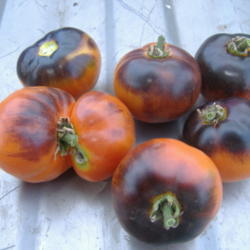
No, this is not the feeling you get shortly after UPS deposits a bathtub-sized box of nursery stock from Friendly Plant Farm. The term is usually reserved for annual plants and can cover anything from severe wilting to healthy-looking plants with a mysterious reluctance to resume growth. But what is it really?
The visible damage usually has causes far simpler than the term "shock" would imply, and much of it is easily prevented. Water root-bound plants enough, and they won't wilt. If plants have lost roots, give them shade and water until roots regrow. Prevent sunburn and wind damage by gradually introducing seedlings to full sun and open air. In fact, it's not too hard for a careful grower to raise tomatoes, lettuce, brassicas and cucurbits that show no signs of transplant shock after they are set out.
But not so with peppers. Even perfect-looking pepper plants often just sit in the ground for two to three weeks before reestablishing vigorous growth. Robert Dufault at Clemson University in South Carolina has been trying to get pepper plants to give up the secrets of their transplant shock for nearly 20 years. One experiment left him baffled.
One way growers "harden" any kind of transplants before moving them out of the greenhouse is by withholding nutrients. This helps keep the plants small and easy to handle. But it also puts them into reverse gear. They don't just resume growth the minute a "starter" fertilizer is applied. Tomatoes and a great many other transplants do show a kind of transplant shock if handled this way. "In fact, it is almost always a bad idea to try to harden any kind of transplant by withholding nutrients," said Dufault.
When he designed an experiment to see if mineral nutrition might be the problem with "shocked" peppers, though, he discovered something startling. By varying fertilizer amounts on bell pepper seedlings, Dufault produced transplants that varied from 'light green and not exactly what you would call 'thrifty' to nice, green, umbrella-shaped plants, but they all performed essentially the same!" All the plants took a couple of weeks to start growing, then went on to produce similar yields.
Dufault says that you should still try to grow the healthiest pepper transplants that you can. But don't pass over transplants that may be a little smaller or not as healthy-looking as you might like -- his research suggests that they may do just as well as others that look better. As to unlocking the secrets of shock, Dufault will keep trying: "I suspect it has something to do with the roots. Peppers are not strong root producers."
 Victory Seed Company has all the seeds you want for your best garden in 2024.
Victory Seed Company has all the seeds you want for your best garden in 2024.
For 25 years, the family-owned Victory Seed Company has provided the highest quality vegetable, herb and flower seeds to families across the country. We are passionate about providing you the best seeds available that give excellent germination, robust plants, and the harvest you want. With a catalog of over a thousand varieties, we have everything, and our prices are the kinds that we'd want to pay. We have hundreds of yesterday's heirloom vegetables, as well as today's award winning hybrid selections. Get to know us by visiting our website and browsing through our online vegetable seed catalog.